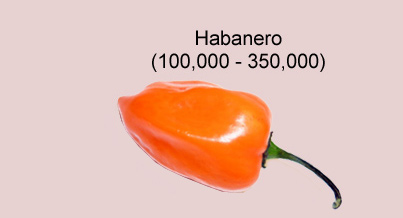 |  |  |
 |  |  |
| The
Habanero chili (Capsicum chinense Jacquin) (originally Spanish
"Javanero,") is one of the the most intensely spicy species of chili
peppers of the Capsicum genus. Unripe habaneros are green, but the
color at maturity varies. Common colors are orange and red,
but brown, and pink are also seen. Typically a ripe habanero
is
20 – 60 millimeters long. Like all Capsicum, the habanero pepper originated in Meso- or South America, most likely the Amazon basin or nearby coastal regions. Upon its discovery by Europeans, it was rapidly disseminated around the world, to the point that 18th-century taxonomists mistook China for its place of origin and called it "capsicum chinense"—the Chinese pepper. The chili's name is derived from the name of the Cuban city of Havana, which was formerly called "La Habana". Today, the crop is most widely cultivated in the Yucatán Peninsula of Mexico. Other modern producers include Belize, Panama, Costa Rica, and some U.S. states including Texas, Idaho, and California. Habaneros are an integral part of Yucatecan food. Habanero chilies accompany most dishes in Yucatan, either in solid or purée/salsa form. The Scotch bonnet is often compared to the habanero since they are two varieties of the same species but have different pod types. Both the Scotch bonnet and the habanero have the characteristic thin, waxy flesh. They have a similar heat level and flavor. Although both varieties average around the same level of heat, the actual degree of "heat" varies greatly with genetics, growing methods, climate, and plant stress. Recently, the habanero's heat, its fruity, citrus-like flavor, and its floral aroma have made it a popular ingredient in hot sauces and spicy foods. | |||||||||||||||||||||
|  | ||||||||||||||||||||
 Try Yorky's Special Recipes |  Read The Chili Story |
